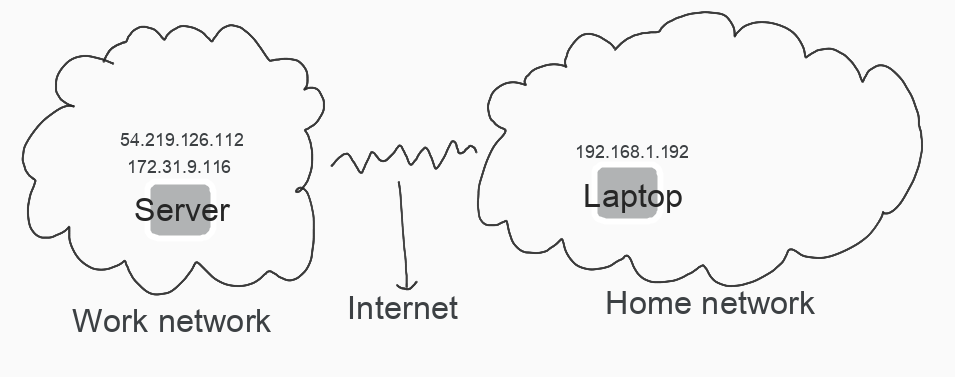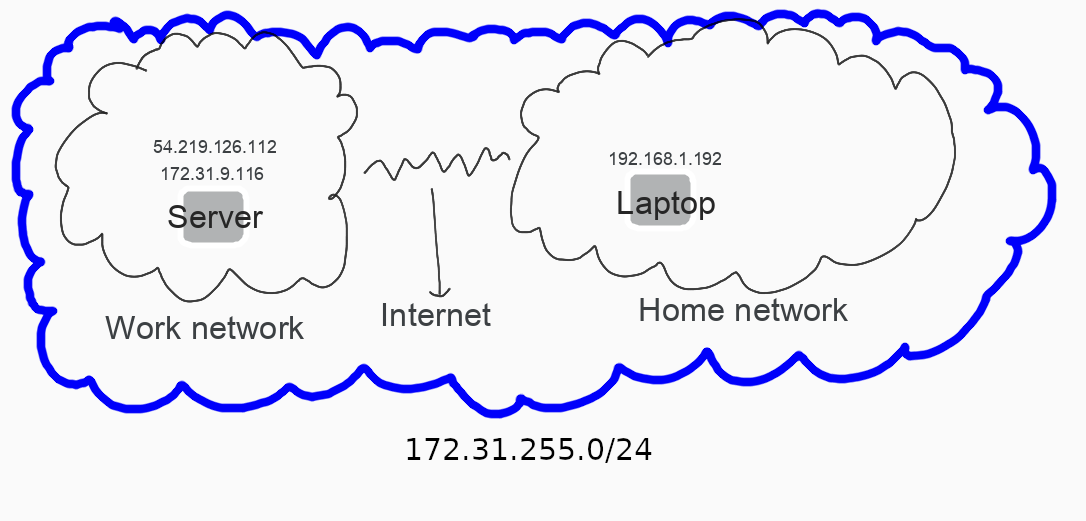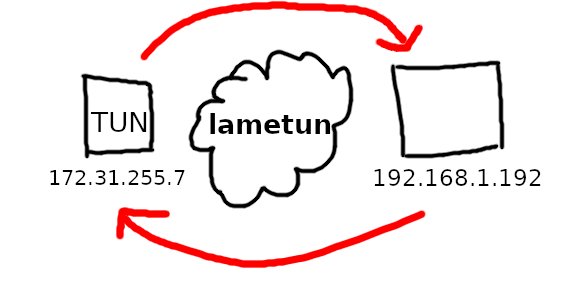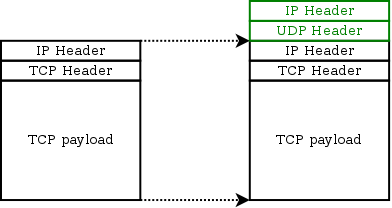VPNs from first principles
Published 2020-09-20 on Farid Zakaria's Blog
If you enjoy the from first principles theme, consider reading the one on containers.
Networking can seem like voodoo; many of us take for granted how data transmits from one computer to the next. Recently, wireguard, has attracted a lot of publicity for it’s inclusion into the Linux kernel & for it’s stated goal of making setting up VPNs simpler.
Behind all the magic, is a very simple premise. Let’s shed some of the complexity and break it down to first principles.
A virtual private network extends a private network across a public network and enables users to send and receive data across shared or public networks as if their computing devices were directly connected to the private network. 1 2
The definition seems simple enough. Bridge two discrete private networks & make them look like they are one.
We will accomplish this task with a tunnel.
Network Reachability
Let’s consider a very simple example with two distinct private networks: home & office.
Home Network: A 192.168.1.0/24 subnet and has a laptop with the private IP address of 192.168.1.192.
Office Network: A 172.31.0.1/20 subnet and has a server with private IP address of 172.31.9.116 & a public IP address of 54.219.126.112.

I did not include the routers or gateways in the figure.
This is pretty common to what most people might experience with their home setup.
private IP addresses are those that can only be reached from other machines within the subnet.
public IP addresses are those that are broadcasted to neighboring routers and exchanged via the BGP protocol.
The goal of the tunnel will be to join these two distinct subnets into a virtual one; a virtual private network (VPN).

Let’s choose a VPN CIDR range of 172.31.255.0/24. I don’t need a subnet so large, so let’s set a mask of /24 which gives us ~254 hosts.
We will then assign two IP addresses within that subnet to the two hosts.
Server: 172.31.255.13
Laptop: 172.31.255.7
The private network address range is 172.16.0.0/12 according to https://www.arin.net/reference/research/statistics/address_filters/
TUN network interface device
The first step in setting up our tunnel will be to create a tun network interface device3. A tun device is a kernel virtual network device, they are not backed by a physical device.
Packets sent by the operating system via the tun device are delivered to a user space program which attaches itself to the device. A userspace program may also pass packets into a tun device. In this case the device delivers these packets to the operating-system network stack thus emulating as if it has arrived from an external source.4
tun devices operate at the L3 layer (IP). There is an analogous tap device that operates at the L2 layer (Ethernet).
# on server & laptop run the following
# adding the user will allow userspace programs running as that user
# to attach to it without needing `sudo`
> sudo ip tuntap add dev tun0 mode tun user $USER
> sudo ip link set dev tun0 up
> ip -d link show tun0
9: tun0: <POINTOPOINT,MULTICAST,NOARP,UP,LOWER_UP> mtu 1500 qdisc pfifo_fast state UP mode DEFAULT group default qlen 500
link/none promiscuity 0 minmtu 68 maxmtu 65535
tun type tun pi on vnet_hdr off persist on user youruser addrgenmode random numtxqueues 1 numrxqueues 1 gso_max_size 65536 gso_max_segs 65535
We then need to assign the new private IP addresses for our new subnet.
# on the laptop run the following
> sudo ip addr add 172.31.255.7/24 dev tun0
# on the server run the following
> sudo ip addr add 172.31.255.13/24 dev tun0
Now let’s create a general routing rule so that anything destined for that subnet routes to the desired tun device.
# run the following on both laptop & server
> sudo ip route add 172.16.0.0/12 dev tun0
# Let's validate our route. Pick a machine and
# test the route for the other one.
> ip route get 172.31.255.8
172.31.255.8 dev tun0 src 172.31.255.7 uid 780412
cache
We make sure to test the route with an IP address not present on either machine, otherwise it will match to the lo (loopback) device.
Great! We have setup some network interfaces and routing rules, but what is actually transmitting the packets to give the illusion of a single network?
Our tunneling software.
lametun
The heart to setting up VPN is the software bridging the packets across the two networks. In our case, we will be using a userspace program and the tun device; however wireguard has included this capability within the kernel itself.
Since this will be a toy example, I’ve named the program lametun. It will be a single golang file with minimal dependencies to demonstrate how simple it is.

lametun will read all incoming packets at a particular UDP port (i.e. 1234) and write it to the tun device.
lametun will read all outgoing packets from the tun device and write it back out the physical network device.
Both the server & laptop will run lametun on UDP port 1234, listening on the physical network device.
Make sure your firewall allows whatever port we are using for lametun. I was using an EC2 host and had to also allow the UDP port through the SecurityGroup as well.
The TUN device however emits raw L3 packets (IP packets), and the IP address of the device is not-routable. Simply copying the packet to the physical device is not enough; it must be routable.
We will encapsulate the packet with a routable IP & UDP header destined for the VPN peer.
UDP is chosen since there is a lot of literature how TCP over TCP is a bad idea; TCP Meltdown.5
Encapsulation
Encapsulation as a concept is straightforward. It is the act of embedding a protocol within the data/payload of another. Here we see an example of embedding TCP-IP within the payload of a UDP packet.6

Using encapsulation, we can now have non-routable packets traverse the Internet. Once they arrive at the lametun destination, the inner packet is forwarded onto the tun device to continue routing.
MTU
Typically, in order to guarantee delivery across the Internet, network devices restrict the maximum transmission unit (MTU), which is the size of the Ethernet frame, to 1500 bytes.
Although IP protocol supports fragmentation, there is no guarantee that every link along the way does. It’s best to stay within the 1500 byte limit.
Given that we are embedding our transmission protocol within a IP-UDP datagram, we must account for this reserved headroom accordingly or risk breaking the 1500 byte boundary.
Given that the IP header is 20 bytes (minimum) and the UDP header is 8 bytes, our new MTU is 1472 bytes.
A simple demonstration will help.
# Upper limit MTU is 1500 safely across the Internet
# IPv4 header is 20 bytes (minimum)
# UDP header is 8 bytes
# ICMP header is 8 bytes
#
# 1500 - 20 (IP) - 8 (UDP) = 1472 new maximum MTU
#
# 1472 - 20 (IP) - 8 (ICMP) = 1444 maximum payload for ICMP payload
# (We actually remove another 4 bytes due to metadata the TUN device includes)
# = 1440 maximum payload
# We will run the following on the laptop
> ping -M do -s 1440 172.31.255.13
# Use wireshark to check the packet
> tshark udp port 1234
1 0.000000000 76.242.91.200 → 172.31.9.116 UDP 1514 1234 → 1234 Len=1472
# If we bump the ICMP payload by a single byte, it will fragment
> ping -M do -s 1441 172.31.255.13
> sudo tshark udp port 1234
1 0.000000000 76.242.91.200 → 172.31.9.116 IPv4 1514 Fragmented IP protocol (proto=UDP 17, off=0, ID=3136)
So we simply need to adjust the MTU on our TUN device accordingly.
# run the following on both laptop and server
> sudo ip link set dev tun0 mtu 1472
Code
Sweet! Enough theory, show me the code!
I’ve kept the code to a single-file for demonstration purposes but you can also find it on GitHub https://github.com/fzakaria/lametun. It is heavily commented for learning purposes.
I tried to make the code somewhat Go-idiomatic without being too pedantic as a learning exercise. If you feel the code can be improved, please reach out or open a pull-request.
package main
import (
"flag"
"fmt"
"golang.org/x/sys/unix"
"net"
"os"
"unsafe"
)
const (
// sizeof(struct ifreq)
IfReqSize = 40
)
// let's open the TUN device
// A tun device is a bit wonky in that you have to first open "/dev/net/tun"
// then run a IOCTL syscall to turn the fd returned for the desired network tun device.
// This code makes use of some unsafe golang code, this is merely to avoid pulling in
// dependencies since this is for demonstration
func openTunDevice(dev string) (*os.File, error) {
fd, err := unix.Open("/dev/net/tun", os.O_RDWR, 0)
if err != nil {
return nil, err
}
// IOCTL for TUN requires the ifreq struct
// https://elixir.bootlin.com/linux/v5.8.10/source/include/uapi/linux/if.h#L234
// we fill in the required struct members such as the device name & that it is a TUN
var ifr [IfReqSize]byte
copy(ifr[:], dev)
*(*uint16)(unsafe.Pointer(&ifr[unix.IFNAMSIZ])) = unix.IFF_TUN
_, _, errno := unix.Syscall(
unix.SYS_IOCTL,
uintptr(fd),
uintptr(unix.TUNSETIFF),
uintptr(unsafe.Pointer(&ifr[0])),
)
if errno != 0 {
return nil, fmt.Errorf("error syscall.Ioctl(): %v\n", errno)
}
unix.SetNonblock(fd, true)
return os.NewFile(uintptr(fd), "/dev/net/tun"), nil
}
func main() {
port := flag.Int("port", 1234, "The protocol port for lametun")
dev := flag.String("device", "tun0", "The TUN device name")
listen := flag.Bool("listen", false, "Whether to designate this machine as the server")
server := flag.String("server", "", "The server to connect to")
flag.Parse()
fmt.Printf("listen:%v server:%v dev:%v port:%v\n", *listen, *server, *dev, *port)
if *listen && *server != "" {
fmt.Fprintf(os.Stderr, "Cannot listen and set server flag\n")
os.Exit(1)
}
if !*listen && *server == "" {
fmt.Fprintf(os.Stderr, "You must specify the server or mark this host to listen\n")
os.Exit(1)
}
tun, err := openTunDevice(*dev)
if err != nil {
panic(err)
}
conn, err := net.ListenUDP("udp4", &net.UDPAddr{Port: *port})
if err != nil {
panic(err)
}
defer conn.Close()
var raddr net.Addr
quit := make(chan struct{})
if *server != "" {
raddr, err = net.ResolveUDPAddr("udp", fmt.Sprintf("%s:%d", *server, *port))
if err != nil {
panic(err)
}
}
go func() {
// we make sure to pick a buffer size at least greater than our MTU
// 2048 is much larger :)
buffer := make([]byte, 2048)
for {
bytes, addr, err := conn.ReadFromUDP(buffer)
if err != nil {
fmt.Fprintf(os.Stderr, "error reading from UDP connection: %v\n", err)
break
}
fmt.Printf("Writing %d bytes to the tun device.\n", bytes)
raddr = addr
// write to the tun device
_, err = tun.Write(buffer[:bytes])
if err != nil {
fmt.Fprintf(os.Stderr, "error writing to tun: %v\n", err)
break
}
}
// signal to terminate
quit <- struct{}{}
}()
go func() {
for {
// we make sure to pick a buffer size at least greater than our MTU
// 2048 is much larger :)
buffer := make([]byte, 2048)
bytes, err := tun.Read(buffer)
if err != nil {
fmt.Fprintf(os.Stderr, "error reading from tun: %v\n", err)
break
}
fmt.Printf("Read %d bytes from the tun device.\n", bytes)
if raddr == nil {
fmt.Printf("UDP connection to server has not been established yet.\n")
continue
}
// at this point the buffer is a complete UDP packet; let's forward it to our UDP peer
_, err = conn.WriteTo(buffer[:bytes], raddr)
if err != nil {
fmt.Fprintf(os.Stderr, "error writing to UDP connection: %v\n", err)
break
}
}
// signal to terminate
quit <- struct{}{}
}()
// wait until an error is given
<-quit
}
Running the code is quite simple.
# the server runs it in listen mode
> ./lametun -listen
# the client needs to provide the server's IP
> ./lametun -server 54.219.126.112
# We can now ping the server from our laptop through the private IP!
> ping 172.31.255.13
PING 172.31.255.13 (172.31.255.13) 56(84) bytes of data.
64 bytes from 172.31.255.13: icmp_seq=1 ttl=64 time=6.42 ms
64 bytes from 172.31.255.13: icmp_seq=2 ttl=64 time=6.33 ms
Encryption & NAT
In order to simplify the tunneling code & avoid having to solve cases where both machines are behind a NAT, lametun requires that one peer acts as the “server”; it must have a publicly accessible IP.
When a UDP packet arrives to the “server”, it will store the remote address which it will use when sending back encapsulated responses. This is how the server can learn about the NAT address of the laptop.
There are solutions to where both machines are behind a NAT such as using STUN; however it adds quite a bit of complexity.
The inner protocol is unencrypted, which can be a problem if it’s also in cleartext like HTTP. More robust solutions like wireguard, encrypt the encapsulated packet. The equivalent would be to extend lametun such that the UDP payloads are encrypted. That part is straightforward, key management is difficult :)
Consider these remaining gaps homework assignment or now you can use the mature product offerings with a better conceptual understanding and appreciation.
-
By Michel Bakni - Derived from files [1], [2] and [3].Dulaney, Emmett (2009) CompTIA Security+ Deluxe Study Guide, Wiley Publishing, Inc., p. 124 ISBN: 9780470372968., CC BY-SA 4.0 ↩
-
https://www.kernel.org/doc/Documentation/networking/tuntap.txt ↩
-
Why TCP Over TCP Is A Bad Idea http://sites.inka.de/bigred/devel/tcp-tcp.html ↩
-
Foo over UDP https://lwn.net/Articles/614348/ ↩
Improve this page @ 34c49b9
The content for this site is
CC-BY-SA.
